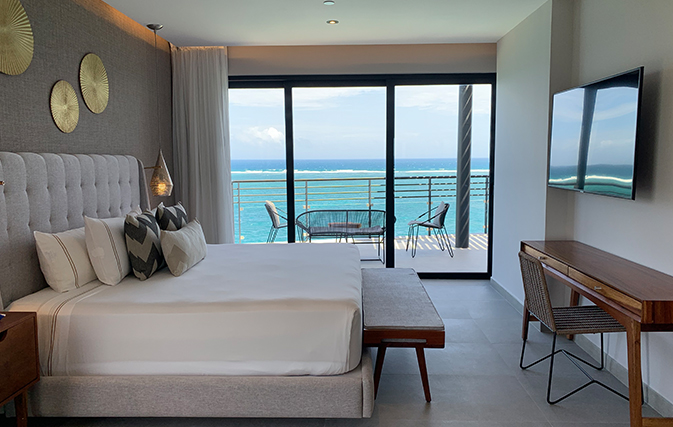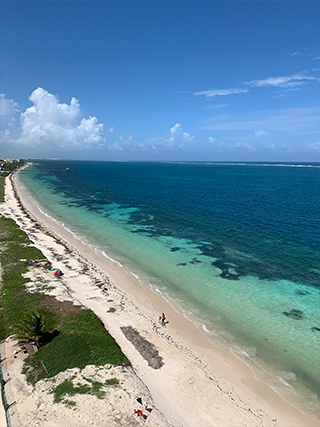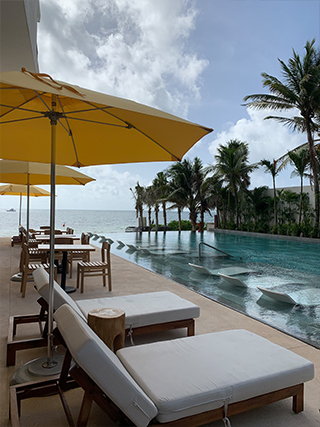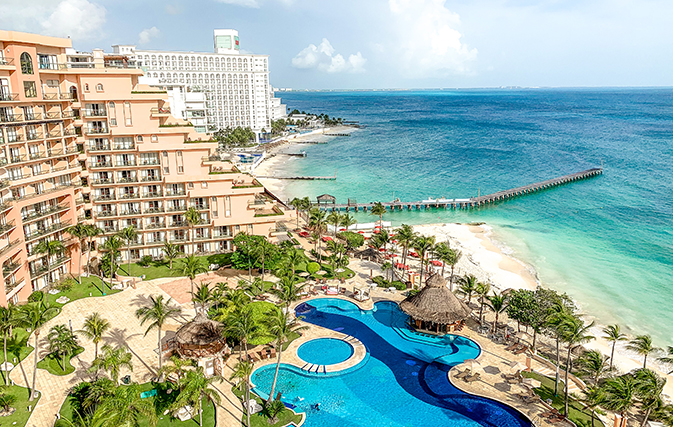CANCUN — With six months of quarantine firmly under my belt, to say “wanderlust has set in,” would be a dramatic understatement. Try downright cabin fever.
As someone who spends roughly five months a year in Mexico, to not have been since February, for me, was unfamiliar and uncomfortable. But August saw the end to my travel drought, as I hopped a flight from New York’s John F. Kennedy, and headed down to Cancun to see how the destination has changed in the age of COVID-19.

The Fives Oceanfront in Puerto Morelos
Mexico had been completely closed to tourism from the end of March through early June. As of June 8, however, Cancun and the entire Mexican Caribbean region has reopened, and they are ready and waiting for visitors to return. But what does tourism to Cancun and Riviera Maya look like in the wake of COVID-19?
“I would describe the vibe [in the destination] as slow but hopeful,” said Renaud Pfeifer, General Manager of the brand-new The Fives Oceanfront in Puerto Morelos. The resort opened in July. “We see signs of steadily increasing demand from several key markets, including the domestic market, which has been critical in our survival. However, the actual pick-up has been slower than anyone would like.”
While travel is open and available, there are new procedures and protocols put in place to help keep travellers and locals safe and COVID-free. The result is a new kind of landscape that will look different to Cancun devotees. Still, the destination is very much ready and willing to accept travellers back to its sunny, sugary shores.
ARRIVING IN CANCUN
While Canada has had its borders closed to non-essential travel, a few direct flights have started to return to Cancun, mostly from Toronto and Montreal with Air Canada, WestJet, and Air Transat.
Air Canada has implemented a CleanCare+ protocol, which is committed to health and safety. These include health screening questions and pre-flight infrared temperature checks, as well as frequent disinfection of high-touch areas. Passengers and crew are required to wear face coverings for the duration of the flight. WestJet and Transat have implemented similar safety procedures.
Upon arrival in Cancun, infrared temperature screenings are put in place to check the temperature of arriving passengers. All terminals are compliant with new hygiene protocols put into place by the government of Quintana Roo. This includes social distancing, antibacterial gel dispensers in all public areas, and a constant cleaning and disinfecting of all areas, including land transportation.
While Canadians travelling internationally are required to quarantine for 14 days after returning to Canada, there is no quarantine policy in place for arrivals into Cancun, or anywhere in Mexico.

The Fives Oceanfront in Puerto Morelos
ON THE GROUND IN CANCUN
The vibe in Cancun is decidedly different. It’s a delicate combination of uncertainty and hesitation, mixed with passionate enthusiasm for the destination’s resilience, and the desire for tourism to return — but as safely as possible.
When I was there in August, most attractions, hotels, and restaurants were capped at 30% occupancy, making a destination as boisterous and energetic as Cancun feel vacant and subdued. Hotels and restaurants were open, but most bars and nightclubs remained closed. A glance out the window from my hotel over to Coco Bongo revealed visions of a ghost town. No traffic, no thumping music — could this really have been Cancun?
That said, things are starting to change. As of Sept. 7 the northern region of the state of Quintana Roo has increased hotel and tourist capacity to 60%. The tourist destinations of Cancun, Cozumel, Playa del Carmen, Tulum, Riviera Maya, Isla Mueres, Costa Mujeres, Puerto Morelos, and Holbox have all allowed an increase in occupancy in hotels, restaurants, shopping centres, theme parks, spas, and golf courses, to 60%. Archaeological sites and beaches will also reopen.
“Similar to many in the hospitality industry we’re facing challenging times and we are working diligently to reactivate our bookings pipeline with the support of our partners,” said Stefania Ballotta, Sales & Marketing Director at the new Barceló Maya Grand Resort, which opened in December 2019. “Most of our efforts are centred on our local partners as there are still a lot of international travel restrictions, however we’re on the road to recovery and are confident that we are heading in the right direction.”
The scenes at the hotels are a bit different from outside the resorts. While social distancing is in effect, travellers are eager to mingle, sip fruity cocktails poolside, and lounge by the beach — which, at the moment, is only open to hotel guests. The beaches in Cancun, all famous for being public, are currently only open to resort guests. And guests are relishing the opportunity to have a powdery Cancun beach all to themselves.
I was able to stay at three resorts during my time in Mexico: Grand Fiesta Americana Coral Beach, Live Aqua Cancun, and The Fives Oceanfront. At each one, hand sanitizer dispensers were widely available, staff was fully masked at all times, and furniture had been rearranged to comply with social distancing.
The only uncomfortable part of the experience, for me, was that guests at all three resorts were not required to wear masks. The hotels encourage mask wearing for guests in public spaces, and Grand Fiesta Americana and Live Aqua offer free masks to guests, but it is not a suggestion that it is enforced. I would estimate that less than 10% of guests were wearing masks in public spaces.
OPEN RESORTS IN CANCUN
The majority of hotels in Cancun and Riviera Maya are open. This includes the majority of hotels in the Hotel Zone and Costa Mujeres, Puerto Morelos, the Riviera Maya, Playa del Carmen, and Cozumel. Depending on the size of the hotel, they can feel very quiet. But for many travellers, that’s exactly what they’re looking for when traveling during a pandemic.
The state of Quintana Roo is handling its reopening with an Epidemiological Traffic Light Strategy. The system keeps areas in the destination in certain colour codes, which change with the number of new cases.
Now that the northern region of Quintana Roo is now operating under a Yellow Light classification, capacity is on the way up at many top resort destinations, to 60%. During my visit, the region was still in an Orange Light (30% capacity) classification. The Green Light means that everything is fully operational, though social distancing measures will still be in place.

The Fives Oceanfront in Puerto Morelos
ADDITIONAL SAFETY MEASURES
In order to provide confidence among travellers, employees, and the community, the Ministry of Tourism in Mexico (SEDETUR), and the State Health Services Department (SESA) launched the ‘Mexican Caribbean Clean & Safe Check Certification,’ which includes health measures for the prevention and slowing of the spread of COVID-19. As of Aug. 18, nearly 7,000 companies, including hotels, transportation companies, tour operators, restaurants, and taxis have registered to obtain the certification.
Similarly, Cancun and the Mexican Caribbean were the first destinations in the Americas to receive the Global Safety Stamp issued by the World Travel and Tourism Council to destinations that adopted its protection standards. This includes temperature screenings – my temperature was even screened at the grocery store – universal masks in all public spaces outside of the resorts, reduced capacity, and social distancing.
THE TAKEAWAY
The decision of whether or not to travel right now is a deeply personal one. However, Mexico, and Cancun and the Riviera Maya in particular, is very much open and ready for tourists to arrive. While the vibe is extremely different from Cancun of years past, there’s no change in enthusiasm from hotels and resorts, who are more than eager to be back in business. Still, it’s with cautious optimism that they are proceeding.
“No one can say for sure [if a recovery is in sight],” said Pfeifer. “But I would say that there are initial signs that recovery could be on the way, but further on the horizon than we had hoped. We expect that both the fall and winter seasons will have important negative deviations from prior years, but that a combination of factors will provide a 2021 summer season that is on par with 2018/19.”
Meagan Drillinger is a freelance writer covering the travel industry, and specializing in Mexico.
